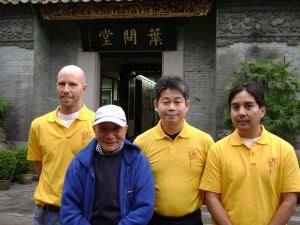Â

What is Wing Chun?
Wing Chun Kuen (Wing Chun Fist) is a martial art that originated over 400 years ago in the Southern Shaolin Temple. It focuses on developing your footwork, sensitivity and speed to outwit an opponent, rather than using mere strength to defeat or control them. Thus, you will frequently hear that Wing Chun is a good style for a woman, or a smaller or weaker person, since you do not necessarily have to be strong and powerful to protect yourself.  Indeed, because it does not rely solely upon physical strength, Wing Chun is suitable for nearly everyone. This is why a main principle of Wing Chun is to use the least amount of energy required to defeat your opponent.
History of Wing Chun
Although there are several versions of how Wing Chun developed, the following story is that of Ng Mui. The story goes that Wing Chun Kuen was named after a woman, Yim Wing Chun, and its roots go back some 400 years to the Southern Shaolin Temple. At that time the Shaolin Temple was home to some of China’s best martial artists and a refuge for freedom fighters who opposed the ruling Qing Government.  Its strength grew and this aroused the concern and fear of the government and so an army was sent to attack the monastery and kill the monks. At first unsuccessful, the government then enlisted the help of some traitors within Shaolin and finally managed to burn the temple down. Many of the monks were killed but among those who survived was the Abbess Ng Mui who found refuge at the White Crane Temple on Tai Leung Mountain near the Yunnan-Szechuan border.
At the time, a bean-curd seller named Yim Yee and his young daughter Yim Wing Chun lived in a nearby town. As father and daughter were selling their bean-curd they met and befriended Ng Mui. Later, as they grew to know each other more, Ng Mui learned that a local bully was intent on forcing Yim Wing Chun to marry him. Ng Mui taught Yim Wing Chun martial art skills she developed based on Yim Wing Chun’s size and the need for quick results. The skills she taught her new student were so successful Yim Wing Chun was able to defeat the bully and was not forced into marriage.  A proud Ng Mui then decided to name the previously unnamed skill after her student.
Grandmaster Ip Chun
There is much more to the legend and there is some debate over its accuracy, but one thing that is not disputed is that Wing Chun Kuen has become one of the most popular styles of Kung Fu in the world. Much of its widespread popularity can be credited to one person, the late Grandmaster Ip Man who helped pave the way for its eventual popularity today.  During his younger days, whilst living in Foshan, South China, Ip Man became famous for his Wing Chun Kung Fu and was undefeated in many fights. He refined and developed his Wing Chun in Foshan, but it was only when he moved to Hong Kong that he began to teach and spread his knowledge. Ip Man taught many people, the most famous being the film star and martial artist Bruce Lee. Ip Man died in 1972 when he was over 70 years old, and he was still practising Wing Chun up until his death. Since that time his eldest son, Ip Chun, has carried on his father’s teaching. He has kept the skill he inherited pure, following the principle of using less strength and energy to defeat an opponent.
Michael Tse
Hong Kong born Michael Tse began studying Wing Chun when he was 14 years old with his uncle Tse Chiu Hong, who was a student of Grandmaster Ip Man.  His uncle taught him until his passing, after which Master Tse began studying with Grandmaster Ip Chun. He completed the Wing Chun system with Grandmaster Ip Chun and developed his skill to a higher level. Already fast and light, he learned how to use sensitivity and footwork to defend against larger attackers.
In 1988, he moved to England after serving eight years with the Royal Hong Kong Police force and began teaching full time. Today, he teaches in London and travels around the world teaching the next generation the many traditional Chinese skills he learned.
What will you learn in Class?
Students will first learn the three hand forms (Siu Lim Tao, Chum Kiu and Biu Jee) before moving on to the weapons forms (butterfly knives and Wing Chun pole) and the Wooden Dummy form. These forms provide the basic knowledge of techniques and applications and develops the muscle and qi necessary. While learning the forms you will also practice Chi Sau which allows you to train the techniques and applications with a partner in a controlled environment to develop your sensitivity and hone your skills.

